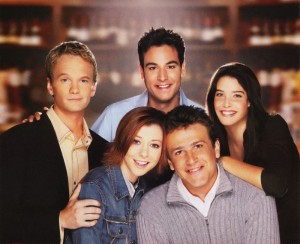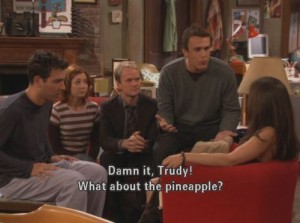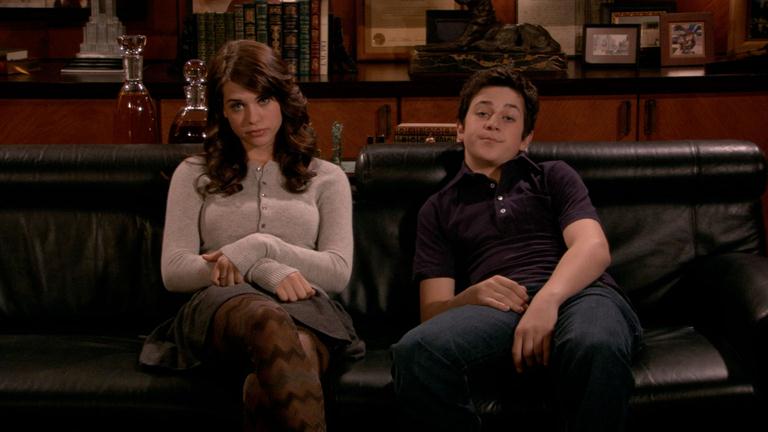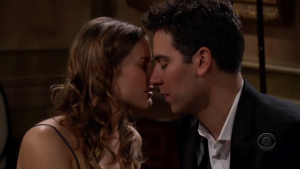Kids, I’ve long wanted to write a retrospective of How I Met Your Mother for this site. Then Grant wrote one and, of course, it’s fantastic and way better than what I would have written.
But I’ll take a crack at it, even though I no longer feel pressure to hit all the major points:
How I Met Your Mother started as an ambitious underdog of a sitcom, a show that wanted to try to both expand the boundaries of the medium and adhere to the classicist comic roots of the sitcom. It’s a single-camera sitcom framed and presented like it’s a multi-camera sitcom, giving it the best of both worlds: the open-ended format of the former, the easygoing warmth of the latter.
For about three or four years it was one of the best shows on TV, with the characterization and creativity matching the fantastic pace of quality of the punchlines.
Then, Britney Spears guest starred, the ratings blew up, the writers were asked to make an ongoing story continually compelling as the show’s end date was repeatedly moved back, and normal sitcom fatigue things happened. The characters’ traits become more cartoony. Stories felt predictable and tired. The show got worse, a lot worse.
But as Grant said, HIMYM at its peak was one of the best TV comedies you’ll ever see. Hilarious, clever, emotive, well-written, cohesive… just brilliant. And those seasons are how I remember HIMYM: as truly one of the best of the past decade.
The concept, in case you live in a cave and have fought off the people talking about the finale with a stick, is that New Yorker Ted Mosby (Josh Radnor) is narrating to his kids the story of him finding the love of his life, their Mother, whose identity is a mystery to viewers.
 Meanwhile, Ted hangs out with his four friends, college buddy Marshall (Jason Segel), Marshall’s fiance/wife Lily (Alyson Hanigan), love interest Robin (Cobie Smulders), and womanizer Barney (Neil Patrick Harris).
Meanwhile, Ted hangs out with his four friends, college buddy Marshall (Jason Segel), Marshall’s fiance/wife Lily (Alyson Hanigan), love interest Robin (Cobie Smulders), and womanizer Barney (Neil Patrick Harris).
(By the way – Segel is totally the MVP of this countdown. This is the fourth entry he’s been featured in!)
As Grant astutely points out, the best actor of the bunch by a mile, Harris, is given the broadest material on the show, which is a little bit of a shame. But he makes a character who could be a misanthropic creep likable and funny, and he knocks his dramatic moments out of the park.
Radnor is solid as Ted, though the character’s balance tended towards “whiny bastard” as the show ran out of ideas for how to make his new girlfriends interesting. Still, Radnor makes the show believable by being equal parts charming and annoying; you can buy that so many girls would fall for him, and you can buy that they’d eventually break up with him, too.
Jason Segel is here playing the Jason Segel we love: A big goofy dude with a mushy heart. The show wisely realized that every permutation of Segel acting sentimental, effervescent, and romantic — really, anything to counter his huge physical stature — is a comic gold mine. Segel’s a decent actor, but his dramatic stories rarely worked as well as his tangential moments, like giving a rousing speech about a burger, singing a song about slapping Barney in the face, or citing the greatness of Star Wars.
The two female leads, Smulders and Hanigan, have always been a little bit more of a mixed bag for me. It’s hard for me to evaluate Hanigan because I find her character, Lily, easily the least compelling on the show — ranging from tolerable to insufferable, depending on the episode.
Smulders, meanwhile, started out the weakest actor of the bunch, but gradually got funnier as the show developed, both because her comic chops developed and because the writers figured out how to use her in funnier ways. Middle seasons frequently gave her funny beats to play, like having her talk about a monkey wearing two tuxedos or — to cite a vein the show frequently mined — acting Canadian.
(Grant’s article goes into depth considering Robin’s role on the show as Ted and Barney’s love interest, so I won’t get into it here.)
Everything I’ve written so far is the type of stuff you can write about a traditional sitcom. But among HIMYM’s most intriguing elements is the way it uses unconventional narrative structures, framed and told in unusual, nonlinear ways.
Take “Three Days of Snow” from the show’s fourth season. The structure of this episode is perhaps the most ambitious ever I’ve ever seen used by a sitcom other than Community’s “Remedial Chaos Theory.”
The episode starts by walking us through two stories in a typical sitcom fashion: 1) Barney and Ted trying to hook up with two college girls in spite of an impending snowstorm, and 2) Lily and Marshall trying to find each other at the airport as they come face to face with the fact that their relationship is losing some of the romantic luster it started with. Other than a few stylistic flairs, most of the episode pretty straightforward.
But in the final five minutes, the show presents that the episode was a carefully constructed jigsaw puzzle: The stories were taking place on different days (remember, it’s titled “Three Days of Snow”). Marshall trying to find Lily was Day 1, Ted and Barney trying to hook up with the college girls was Day 2, and Lily trying to find Marshall was Day 3.
The way it all comes together is extremely clever and satisfying, and the resolution with Marshall and Lily is one of their most romantic moments of the series.
This is probably one of my top 15 or so episodes of the show, but so much of that is from the way the structure amplifies the jokes and the stories. If it had just been the two stories in a typical, linear fashion, the episode would have been decent, but would not have had the same impact.
Not every episode is as clever as that, but even the little bits of unconventional narrative technique can make a huge difference in elevating HIMYM from good to great. Consider “Nothing Good Happens After 2 A.M.” from the show’s first season, when Ted has a conversation with a hallucinated version of his long-distance girlfriend, or “Dowisetrepla” from the third season when we repeatedly see Ted revise the story.
In both of these cases, the storytelling gimmicks improve the episode they’re in. I almost always have enjoyed the in-episode bits of structural creativity.
More troublesome for the show was the use of gimmicks across seasons. This happened with things like recurring gags, flash-forwards, and other foreshadowing. It’s a natural extension of the show’s premise and commitment to telling stories in unusual ways, I suppose. But most of what these gimmicks did was build up expectations for the upcoming moments, which rarely had the impact they should have.
It’s probably worth noting that the best and most beloved season — the second — is the least experimental early season (the one that most resembles a typical sitcom). But I’ll also point out that the second-best season — the fourth — is the MOST experimental of the six seasons I’ve seen.
Oh yeah, I guess I should have said that earlier: I stopped watching the show towards the end of the sixth season because I lost interest in the show. It just frustrated me how much creativity, humor, and characterization it squandered, so I gave up. And I never heard anything that compelled me back.
I am currently rewatching the show with my wife, little by little, but seeing as I’ve missed more than a third of the show’s run — including the curiously-structured final season — I admit that my knowledge of the show is incomplete.
But those first few seasons? Man. Some of my favorite TV ever, and a strong candidate for best rerun show ever. If I’m flipping through Netflix, trying to figure out what to watch, and I see HIMYM? Bang, bang, bangity bang.
For the hell of it, my five favorite episodes (off the top of my head):
 5. The Pineapple Incident (Season 1, Episode 10)
5. The Pineapple Incident (Season 1, Episode 10)
There are a lot of episodes that I considered to round off this list, but the scales ultimately tipped in favor of “The Pineapple Incident” because it guest stars Winnie Cooper.
The episode opens at the bar with Barney complaining that Ted overthinks everything, and so Ted quickly takes five shots. Shortly afterwards, he blacks out and wakes up the next morning in bed next to a woman. What happened? And who is the woman?
Bit by bit, Ted pieces together the previous night and unravels every mystery… except the origin of a pineapple on Ted’s bedstand. This early standout makes great use of the show’s willingness to use nonlinear structure and features plenty of great jokes, my favorite of which is drunk Ted repeatedly using the phrase “hauntingly beautiful.”
4. The Platinum Rule (Season 3, Episode 11)
NPH gives a fantastic, hilarious performance this episode as he narrates the consequences of breaking “The Platinum Rule” — a reference to “The Golden Rule” of “love thy neighbor,” which is not actually “The Golden Rule” as Ted points out.
This is another nonlinear episode as we travel between three parallel stories that all follow the same arc: Wendy the Waitress dating Barney, Marshall and Lily “dating” a neighbor couple, and Robin dating her TV co-host. It’s a fun, hilarious episode with a remarkable quantity of jokes packed into 22 minutes.
3. Drumroll, Please (Season 1, Episode 13)
Ah, Victoria — she was cast to be The Mother when the show’s writers thought that HIMYM was going to get cancelled after its initial thirteen-episode pickup. For all they knew “Drumroll, Please” was going to be the last episode of the series, so they gave it everything they had. They made Ted’s night with Victoria, and his quest to find her the next day, as romantic and memorable as possible.
The show’s best was yet to come, but there’s a part of me that always wishes the show had ended here. The tale of how Ted met The Mother would have been a short, sweet one with a happy ending, as opposed to the rambly, often incoherent one we got. I can’t complain, though. Because the show carried on, we ended up with gems like…
2. Sorry, Bro (Season 4, Episode 16)
Whenever you see web sites rank their favorite episodes, the other four on this list usually appear in the top ten. But I rarely see “Sorry, Bro” ranked this high. I guess I just have a soft spot for it. It’s probably because it features something called The Pants Story.
Framed around a late night/early morning stop to the bar, “Sorry, Bro” features Ted and Marshall each recounting a story: Ted of getting lunch with his douchey ex-girlfriend Karen, and Marshall a story about forgetting his pants. Spliced through each story are lots of mini-flashbacks and great continuity gag.
But the reason I love it is that it’s just a damn hilarious episode. “The Pants Story” is intentionally anti-climactic, but Barney’s buildup to the story makes the anti-climax the funniest possible outcome. Ted’s story, meanwhile, is one of those classic HIMYM instances of taking some truths about dating — that people backslide to ex-partners, that people are often attracted to partners who are wrong for them — and encapsulates in a funny story.
Throw in a bunch of clever gags, a reference to The Wire, and a final structural twist, and you have one of the show’s most classic outings.
1. Slap Bet (Season 2, Episode 9)
It’s pretty incredible that the two funniest gags the show ever did both appeared in the same episode — and were so beloved that the writers expanded them into recurring stories that built to the end of the series. Marshall’s slap bet with Barney and Robin’s career as a teen pop star are, independently, fantastic. But together? Pantheon-level stuff. Pure genius.
And the path to get to the conclusion that ties them together is hilarious, too: Ted tries desperately to figure out Robin’s mall-related secret as the rest of the gang navigates the rules of a “slap bet.” Beyond the joke-packed script, “Slap Bet” is a good character story for Ted and Robin, who address how close they’re becoming, and how reluctant Robin is to share her life with somebody else.
But, “Slap Bet” could’ve made this list from the Robin Sparkles reveal alone. Sing it with me: “Let’s go to the mall, let’s go the ma-a-a-all.”
(“And don’t forget the robot.”)







